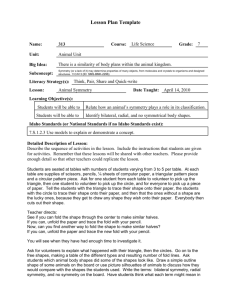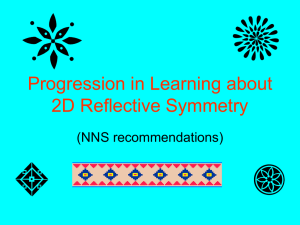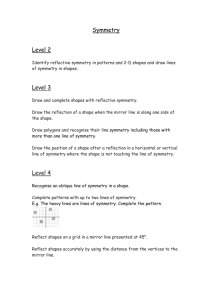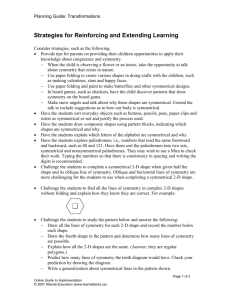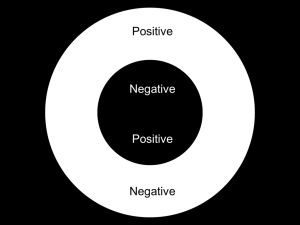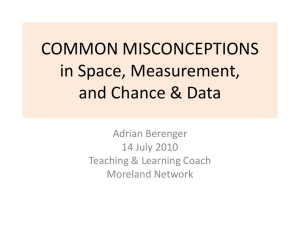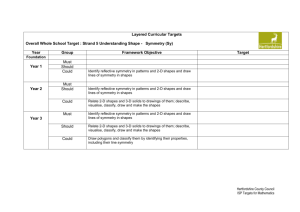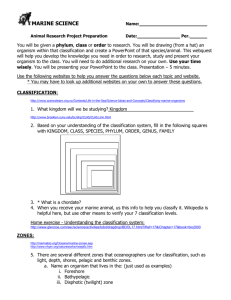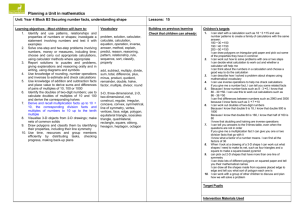2D - Stage 2
advertisement
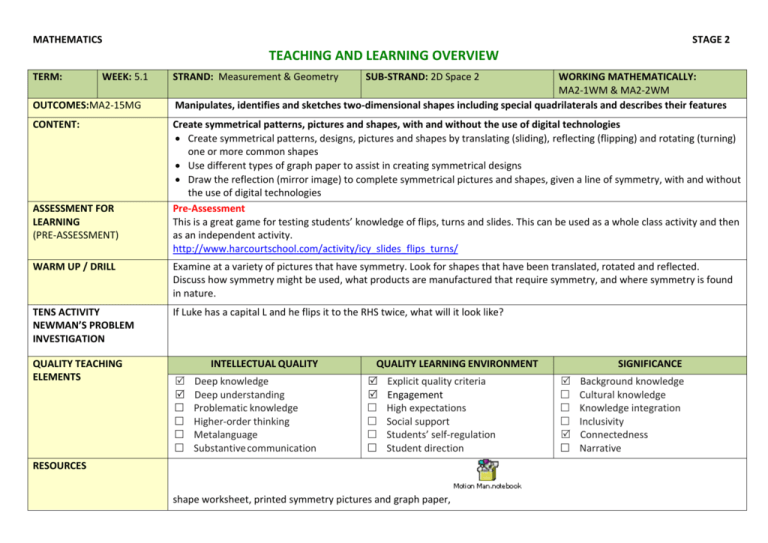
MATHEMATICS STAGE 2 TEACHING AND LEARNING OVERVIEW TERM: WEEK: 5.1 OUTCOMES:MA2-15MG CONTENT: ASSESSMENT FOR LEARNING (PRE-ASSESSMENT) STRAND: Measurement & Geometry SUB-STRAND: 2D Space 2 WORKING MATHEMATICALLY: MA2-1WM & MA2-2WM Manipulates, identifies and sketches two-dimensional shapes including special quadrilaterals and describes their features Create symmetrical patterns, pictures and shapes, with and without the use of digital technologies Create symmetrical patterns, designs, pictures and shapes by translating (sliding), reflecting (flipping) and rotating (turning) one or more common shapes Use different types of graph paper to assist in creating symmetrical designs Draw the reflection (mirror image) to complete symmetrical pictures and shapes, given a line of symmetry, with and without the use of digital technologies Pre-Assessment This is a great game for testing students’ knowledge of flips, turns and slides. This can be used as a whole class activity and then as an independent activity. http://www.harcourtschool.com/activity/icy_slides_flips_turns/ WARM UP / DRILL Examine at a variety of pictures that have symmetry. Look for shapes that have been translated, rotated and reflected. Discuss how symmetry might be used, what products are manufactured that require symmetry, and where symmetry is found in nature. TENS ACTIVITY NEWMAN’S PROBLEM INVESTIGATION If Luke has a capital L and he flips it to the RHS twice, what will it look like? QUALITY TEACHING ELEMENTS INTELLECTUAL QUALITY Deep knowledge Deep understanding Problematic knowledge Higher-order thinking Metalanguage Substantive communication QUALITY LEARNING ENVIRONMENT Explicit quality criteria Engagement High expectations Social support Students’ self-regulation Student direction RESOURCES shape worksheet, printed symmetry pictures and graph paper, SIGNIFICANCE Background knowledge Cultural knowledge Knowledge integration Inclusivity Connectedness Narrative TEACHING AND LEARNING EXPERIENCES WHOLE CLASS INSTRUCTION MODELLED ACTIVITIES Explicitly communicate lesson outcomes and expectations of work quality. Define and reinforce metalanguage used in the unit, translating (sliding), reflecting (flipping) and rotating (turning). Film Clip: This short film clip has students dancing using flips, turns and slides as moves. Although the terminology is based on flip, slip and turn, it is still a good activity to help students remember what a flip, turn and slide is. https://www.youtube.com/watch? v=sSsasVyYcdM&feature=youtu.be Video: This link introduces students to the formal terminology, of translate, rotate and reflect mixed in with a song they know. https://www.youtube.com/watch? v=NKtJd1hkI9k Using Graph Paper: Explicitly explain to students how graph paper can assist in completing an incomplete picture with a line of symmetry. GUIDED & INDEPENDENT ACTIVITIES LEARNING SEQUENCE Remediation S1 or Early S2 LEARNING SEQUENCE S2 LEARNING SEQUENCE Extension Late S2 or Early S3 EVALUATION & REFLECTION Provide students with a page of common shapes drawn down the left hand side. Walk students through translating, reflecting and rotating the shapes. Students can then be asked to draw their own shape and have a partner translate, reflect and rotate it. Label their shape with the actions taken. Use the notebook file below to introduce translating, reflecting and rotating. https://interactivemaths.wikispaces.com/file/detail/Motion%20Man.notebook Reflections: Students complete the mirror image of a given picture. This site provides a variety of templates that can be printed. Alternately, print plain dot paper to create your own designs. http://artforkidshub.com/10-free-coloring-pages-bug-symmetry/ Transformation Practice: Print graph paper, with size of your choosing. Instruct students to draw a common shape of teacher’s choice. Students translate, reflect and rotate the shape to create patterns as directed. Compare the end product as a whole class to see who has the correct pattern. This activity can be differentiated to include varying degrees of difficulty. Students should then create their own designs. This site allows you to print your own graph paper. http://www.printfreegraphpaper.com/ Digital alphabet Symmetry: Students to look at capital letters using the site below and decide if they have vertical or horizontal symmetry. http://gwydir.demon.co.uk/jo/symmetry/refsym.htm Investigation: Students investigate the classroom to find items that have been either translated, rotated or reflected. Compile a class list of things found. Assessment: Provide students with graph paper and fold it into 4 quarters. Ask them to draw a pattern in one corner (¼ of the graph). Then give to a partner and ask them to flip, rotate and slide to complete the other three corners. Symmetry Activity: Show students the website below and have them recreate a quilt of their own. Use grid paper to assist students to make their own quilt. http://greatmathsgames.com/Symmetry/quilt/quilt.html Student Engagement: Achievement of Outcomes: Resources: Follow Up:
